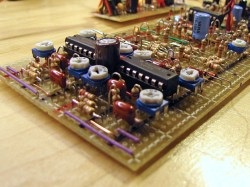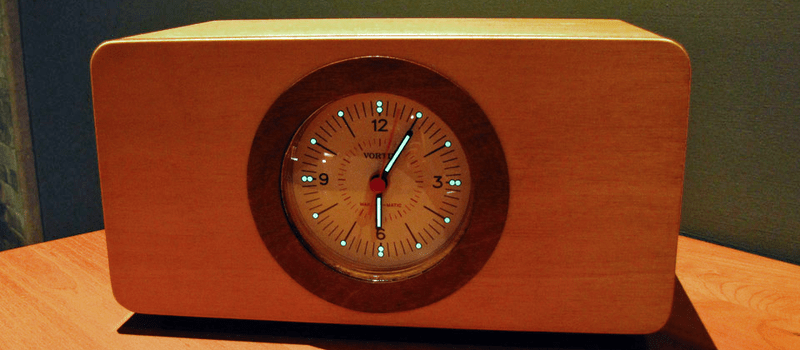Even though [Stefan] sent in this link with the heading “Another Sunrise Alarm Clock“, it’s anything but plain. Sure, from the outside it looks like a simple and refined design, but the story of getting there is hardly straightforward.
 Take that nice-looking luminous dial. [Stefan] made it himself, using the same techniques that he’s used for making his own watch faces. (Amazingly, he prints them out on a color ink-jet.) This is a sunrise wake-up clock, but if the bright LEDs don’t wake him up, there’s also a vintage DIY synthesizer project stuffed in the box in place of a cheap piezo buzzer. Even the wooden case shows attention to detail — it has nice edging done on a router table.
Take that nice-looking luminous dial. [Stefan] made it himself, using the same techniques that he’s used for making his own watch faces. (Amazingly, he prints them out on a color ink-jet.) This is a sunrise wake-up clock, but if the bright LEDs don’t wake him up, there’s also a vintage DIY synthesizer project stuffed in the box in place of a cheap piezo buzzer. Even the wooden case shows attention to detail — it has nice edging done on a router table.
So yeah, we’ve all seen clocks before. But this one is very personal, melding together a few of [Stefan]’s hobbies into one useful, and good-looking, device.















No snooze button!? Crazy I tell you! :P
I like the sound, somewhere between a harmonica and bagpipes. Very strange sound.
Very nice job on the… sound card? I’ve never seen a homebrew alarm clock quite like this one; it looks so simple but definitely is not.
Thanks. Ever since I built this clock, the lack of a snooze button has ensured that I actually get up on time. I’ve found that the sound works well for an alarm clock: not jarring, yet somehow annoying so I don’t just lay there and listen to it. I like your description of it. :-)
I think a pack of 4 LiFePO4 batteries would have been simpler.
http://nerdralph.blogspot.ca/2016/01/a-36v-lifepo4-charger-for-under-50c.html
Perhaps, but I had the Eneloops on hand.
Beautiful clock. Curious what program do you use to design the stripboard layout?
A very simple and very old program that I wrote back in the DOS days, and have since “ported” to Windows. It’s still mostly keyboard driven, although it does have some minimal mouse support.
This is a wonderful bit of work and having just finished one furniture project this may be next. Here’s the inevitable awful question: Could one more-easily approximate the Chord EGG in software so that you could use one or a couple of Atmel chips/Arduino/RPi Zero instead of the whole synthesizer build?
Blasphemy! But yeah, you probably could. I’m not familiar with the Atmel or Arduino at all, but I happen to be doing an audio project on an RPi3 right now, and I’m sure even an RPi0 could handle this with the appropriate programming (and the addition of an audio output, which it is lacking by default). Someone more versed in DSP would probably better be able to tell you exactly how to go about it, especially recreating the swooshing filter sweeps of the original.
That clock is simply gorgeous! It’s great to see a quality build to match the wizardry inside.